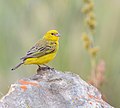The genus Sicalis was introduced in 1828 by the German zoologist Friedrich Boie.[1] The name is from the Ancient Greek σικαλίς/sikalis, a small, black-headed bird, mentioned by Epicharmus, Aristotle, and other authors. It was perhaps a warbler in the genus Sylvia.[2] The type species is the saffron finch.[3] The genus now contains 13 species.[4]
More information Image, Scientific name ...
| Image | Scientific name | Common name | Distribution |
 | Sicalis citrina | Stripe-tailed yellow finch | Argentina, Bolivia, Brazil, Colombia, Guyana, Paraguay, Peru, Suriname, and Venezuela |
 | Sicalis taczanowskii | Sulphur-throated finch | Ecuador and Peru |
 | Sicalis uropigyalis | Bright-rumped yellow finch | the Altiplano of Peru, Bolivia and northern Chile and Argentina |
 | Sicalis flaveola | Saffron finch | Ecuador, western Peru, eastern and southern Brazil, Bolivia, Paraguay, Uruguay, northern Argentina, and Trinidad and Tobago |
 | Sicalis columbiana | Orange-fronted yellow finch | Brazil, Colombia and Venezuela |
 | Sicalis luteola | Grassland yellow finch | Colombia south and east to the Guianas and central Ecuador, Peru and Brazil. Birds which breed further south in Argentina and Uruguay migrate to Bolivia and southern Brazil in the austral winter. There are also isolated populations in Central America and Mexico |
 | Sicalis luteocephala | Citron-headed yellow finch | Andes of Bolivia and far northern Argentina |
 | Sicalis lebruni | Patagonian yellow finch | Argentina and Tierra del Fuego; also Chile. |
 | Sicalis olivascens | Greenish yellow finch | the Andes of Argentina, Bolivia, Chile, and Peru |
 | Sicalis mendozae | Monte yellow finch | western Argentina. |
 | Sicalis auriventris | Greater yellow finch | Argentina and Chile |
| Sicalis raimondii | Raimondi's yellow finch | Peru |
 | Sicalis lutea | Puna yellow finch | Argentina, Bolivia, and Peru |
|
Close













